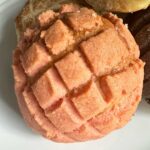
Conchas
Light textured Mexican sweet bread.
Servings 12 conchas
Cost 5
Ingredients
- 3 large eggs, room temperature
- 1 stick unsalted butter (114 grams)
- 3 cups bread flour plus an extra ¼ to ⅓ cup (410 to 440 grams)
- ⅓ cup plus 2 teaspoons sugar (85 grams)
- 2 ½ teaspoons instant yeast
- 1 ¼ teaspoons salt reduce to 1 if using salted butter
- 1 ½ teaspoons vanilla extract
- ½ teaspoon anise extract (optional)
Crunchy Topping
- ½ cup unsalted butter, softened (114 grams)
- ½ cup plus 2 tablespoons sugar (125 grams)
- ¼ teaspoon salt
- 1 teaspoon vanilla (or use other flavorings)
- ¾ cup plus 2 tablespoons bread flour or up to a cup of all-purpose (127 grams)
Instructions
- First, make sure your egg are room temperature or even a little on the warm side by dunking them in hot water. Set aside.
- Cut the butter into 8 chunks and warm in the microwave at 50% power just until very soft and squishy. It's okay if it's partially melted.
- In the bowl of a stand mixer, combine 3 cups (400 grams) of the bread flour, sugar and instant yeast. Keep the salt nearby, but don't add it yet.
- In small saucepan (or microwave safe measuring cup), heat the milk to 130 degrees F. Pour the extremely warm milk over the flour mixture and stir until ingredients are moistened. Add the squishy butter, then add the eggs, one by one, stirring by hand until they are absorbed.
- Add the salt and the flavorings and stir until blended. Everything should be in the mixing bowl now except for that last ¼ cup of flour, which is on standby.
- Set the mixing bowl on the stand mixer with the dough hook attached and knead for about 2 minutes, stopping to scrape sides of the bowl. The dough should not be sticking to the sides of the bowl at this point. It should be clinging loosely to the hook but slowly falling off the hook because it's still too soft. Add 2 tablespoons more flour and keep kneading. Continue adding flour as needed until the dough clings to the hook but is still very soft and not sticky.
- Transfer to a bowl slicked with a little oil. Cover and let rise in a warm place until doubled. This dough is a bit of a slow riser, so it could take up to an hour and a half. Make the cookie topping during the first rise.
Conchas Cookie Topping
- With a scraper or handheld mixer, beat the softened butter and sugar just until they come together, then beat in the vanilla extract and salt. Gradually add the flour. Start with ¾ cup and then add just as much as you need to get a pliable dough. If you use a scale it should be about 127 grams total, but flours can vary in how absorbent they are. Shape into a 2 inch wide log, wrap and chill briefly.
- Alternatively, if you'd like to make it in different colors and flavors, mix the butter and sugar, then divide into 3 equal parts. Flavor each part with a dash of whatever flavoring you've chosen and a pinch of salt, then add coloring if using. Add about 45 grams of flour to each section.
Shaping
- Grease two 9x13 inch cake pans.
- Punch down the risen dough and shape it into twelve 2 ½ oz balls or 14 slightly smaller balls. Arrange 6 or7 to a pan, spacing evenly. Set aside and set the timer for an hour. This will be the second rise.
- If your oven takes a while to preheat, go ahead and preheat to 350 degrees F.
- Meanwhile, grab your cookie dough log (or logs). Cut 12 equal pieces. Press pieces into flat circles. The dough should start out cold, but will soften as you press it. Lay each circle over a rising dough piece.
- Using a razor blade or sharp knife, score lines through the cookie dough, doing your best to score only through the cookie dough and not the roll.
- Cover very loosely with lightly plastic wrap and let the dough finish rising. The rolls will not double in size during the second rise, they'll just puff up substantially and you might see some little holes forming.
- When ready to bake, bake the rolls for 22 to 25 minutes. Larger rolls will take up to 25 the smaller ones might be done as early as 20. Let cool before serving.
- You can serve slightly warm, but these are actually a little better if you let them cool because the cookie part cools and crisps.